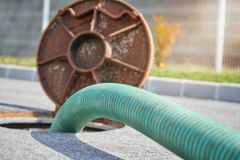Lakeville Septic Repair Company Explains How a Septic System Operates

To avoid expensive septic repair and replacement, B’s Pumping Service in Lakeville, MN, recommends familiarizing yourself with how a septic system works. By understanding how to take care of your tank and what happens when you flush the toilet, you can ensure that you never experience property damage or exposure to raw sewage.
Once wastewater goes down your drain, here’s the path it takes through your septic system before returning to the groundwater system again:
 Enters Your Septic Tank: Wastewater and solid sewage enter your septic tank, where the solids float to the bottom and form a layer of sludge. Over time, this sludge builds up and must be removed by a septic pumping company. The liquids remain until they’re thoroughly treated.
Enters Your Septic Tank: Wastewater and solid sewage enter your septic tank, where the solids float to the bottom and form a layer of sludge. Over time, this sludge builds up and must be removed by a septic pumping company. The liquids remain until they’re thoroughly treated.- Enters the Leach Field: A septic tank must maintain a balance of liquids and solids, so that it can treat water and divert it into the leach field. This component stretches from your tank out into your yard, where treated water is filtered through a layer of rocks and soil.
- Slowly Returns to the Aquifer: If a septic pump is functioning appropriately, then solid waste will accumulate in the tank until a septic pumping company removes it. In the meantime, all liquid waste will return to the groundwater system.
If your septic system isn’t in proper working condition, then your tank can crack and leak sewage onto your property or cause a drain or toilet backup. This is why it’s crucial to have septic repair if it’s needed and avoid placing inorganic or toxic materials down your drains. When properly maintained, a tank will last at least 15 or 20 years. To learn more about B’s Pumping Service, call (952) 469-2573, or visit them online for a complete list of services, ranging from septic repair, pumping, and comprehensive maintenance.
About the Business
Have a question? Ask the experts!
Send your question

